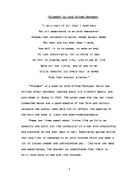Break, Break, Break by Alfred Lord Tennyson is a lyrical poem that portrays the despairing emotional fibre of the poet through the melancholic presentation of the poetic voice. The poem is generally believed to have been written in response to the death of Tennyson's close friend and the poem therefore centers on Tennyson's grief inherent within this loss. The poet presents the synonymous grief and emptiness exemplified in the speaker's realisation of the loss of youth and humanity's powerlessness against time through his effective employment of poetic form, imagery, phonetics, metre and structure. In doing so, the poet presents and explores the central concern of the poem: the inexorability of time, and thus the overlooked value of youth.
In Break, Break, Break, Tennyson immediately establishes a depressive atmosphere in the first quatrain. For example, the use of repetition, 'Break, break, break', in the first line, and indeed in the title, creates a despairing tone in itself, mirroring the melancholy of the poetic voice. This effect is enhanced through the employment of the alliterative plosive in this example, creating a sense of despondency intertwined with indignation inherent in the emotional fibre of the speaker. Furthermore, Tennyson introduces the extended metaphor central to the poem in this first stanza: 'On thy cold gray stones, O Sea! / And I would that my tongue could utter / The thoughts that arise in me.' In this example, the poetic voice directly addresses the sea, as if he is searching for a form of understanding from the greater power of nature in order to alleviate his angst. It is within this mode of personification that the poet achieves a sense of poignancy in his presentation of the melancholy of the speaker and in turn, emphasises his sense of dejection and inadequacy; the speaker is attempting to address something greater beyond the endless cycle of life and death in order to come to terms with the inevitability, however futile that may be. This is further highlighted through the negative connotations associated with 'cold gray'. Within this first quatrain, Tennyson presents the emotional state of the poetic voice, creating a platform for the introduction and exploration of the wider themes of the poem that are elaborated upon in the remaining stanzas.
In Break, Break, Break, Tennyson immediately establishes a depressive atmosphere in the first quatrain. For example, the use of repetition, 'Break, break, break', in the first line, and indeed in the title, creates a despairing tone in itself, mirroring the melancholy of the poetic voice. This effect is enhanced through the employment of the alliterative plosive in this example, creating a sense of despondency intertwined with indignation inherent in the emotional fibre of the speaker. Furthermore, Tennyson introduces the extended metaphor central to the poem in this first stanza: 'On thy cold gray stones, O Sea! / And I would that my tongue could utter / The thoughts that arise in me.' In this example, the poetic voice directly addresses the sea, as if he is searching for a form of understanding from the greater power of nature in order to alleviate his angst. It is within this mode of personification that the poet achieves a sense of poignancy in his presentation of the melancholy of the speaker and in turn, emphasises his sense of dejection and inadequacy; the speaker is attempting to address something greater beyond the endless cycle of life and death in order to come to terms with the inevitability, however futile that may be. This is further highlighted through the negative connotations associated with 'cold gray'. Within this first quatrain, Tennyson presents the emotional state of the poetic voice, creating a platform for the introduction and exploration of the wider themes of the poem that are elaborated upon in the remaining stanzas.







